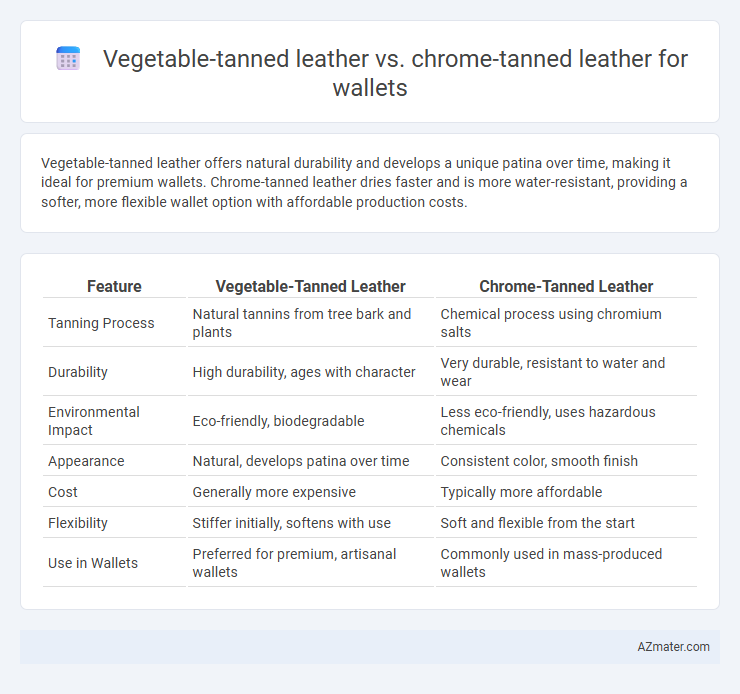Vegetable-tanned leather offers natural durability and develops a unique patina over time, making it ideal for premium wallets. Chrome-tanned leather dries faster and is more water-resistant, providing a softer, more flexible wallet option with affordable production costs.
Table of Comparison
| Feature | Vegetable-Tanned Leather | Chrome-Tanned Leather |
|---|---|---|
| Tanning Process | Natural tannins from tree bark and plants | Chemical process using chromium salts |
| Durability | High durability, ages with character | Very durable, resistant to water and wear |
| Environmental Impact | Eco-friendly, biodegradable | Less eco-friendly, uses hazardous chemicals |
| Appearance | Natural, develops patina over time | Consistent color, smooth finish |
| Cost | Generally more expensive | Typically more affordable |
| Flexibility | Stiffer initially, softens with use | Soft and flexible from the start |
| Use in Wallets | Preferred for premium, artisanal wallets | Commonly used in mass-produced wallets |
Introduction to Leather Tanning Methods
Vegetable-tanned leather, crafted using natural tannins from tree bark and plants, offers durability and develops a rich patina over time, making it ideal for wallets seeking an eco-friendly and traditional appeal. Chrome-tanned leather undergoes a faster chemical process using chromium salts, resulting in softer, more water-resistant material with consistent color, popular for mass-produced wallets. Understanding these tanning methods is essential for selecting wallets that balance aesthetics, longevity, and environmental impact.
What is Vegetable-Tanned Leather?
Vegetable-tanned leather is crafted using natural tannins derived from tree bark, leaves, and other plant materials, resulting in a durable and environmentally friendly material ideal for wallets. This tanning method produces leather that develops a rich patina over time, enhancing its aesthetic appeal and uniqueness. Compared to chrome-tanned leather, vegetable-tanned leather is less water-resistant but offers superior breathability and biodegradability, making it preferred by eco-conscious consumers.
What is Chrome-Tanned Leather?
Chrome-tanned leather is a type of leather processed using chromium salts, primarily chromium sulfate, which accelerates tanning and produces a soft, flexible material resistant to water and stains. This method results in leather with a consistent color and texture, making it popular for wallets that require durability and a smooth finish. Chrome-tanned leather also offers increased resistance to heat and aging compared to vegetable-tanned leather, making it ideal for daily-use accessories.
Appearance and Texture Differences
Vegetable-tanned leather for wallets features a rich, natural patina that deepens over time, showcasing unique grain patterns and a matte finish with a firm yet supple texture. Chrome-tanned leather offers a more uniform color and smoother surface, often appearing glossier and softer to the touch due to its chemical tanning process. The contrasting tanning methods result in vegetable-tanned leather wallets exuding rustic elegance, while chrome-tanned options provide modern sleekness and enhanced flexibility.
Durability and Longevity Comparison
Vegetable-tanned leather wallets develop a rich patina over time, enhancing durability through a natural curing process that resists wear and tear. Chrome-tanned leather offers superior water resistance and retains flexibility longer, but may show signs of fading and cracking earlier under heavy use. For longevity, vegetable-tanned leather typically outlasts chrome-tanned due to its firm structure and ability to age gracefully, making it ideal for durable, long-lasting wallets.
Environmental Impact of Each Tanning Process
Vegetable-tanned leather uses natural tannins from tree bark and plant extracts, making it a biodegradable and eco-friendly option with minimal chemical waste, whereas chrome-tanned leather relies on chromium salts that pose significant environmental risks due to toxic runoff and heavy metal pollution. The vegetable tanning process is slower but generates less hazardous waste, supporting sustainable leather production and reducing soil and water contamination. In contrast, chrome tanning accelerates processing times but contributes to persistent environmental pollution and requires advanced treatment methods to mitigate its harmful impact.
Aging and Patina Development
Vegetable-tanned leather develops a rich, unique patina over time, reflecting the wallet owner's usage and environment with deepening color and texture. Chrome-tanned leather, while more resistant to water and stains, tends to maintain a consistent appearance with minimal aging effects or patina development. The natural aging process of vegetable-tanned leather enhances both its aesthetic and tactile qualities, making it highly valued for wallets that showcase personal character over time.
Price and Affordability Factors
Vegetable-tanned leather wallets tend to be more expensive due to the labor-intensive natural tanning process and longer curing time, which adds to production costs and retail prices. Chrome-tanned leather wallets are generally more affordable because the chemical tanning process is faster and requires less manual effort, making mass production cost-effective. Price-sensitive buyers often choose chrome-tanned leather for budget-friendly wallets, while those valuing durability and natural aging may invest more in vegetable-tanned options.
Suitability for Wallet Crafting
Vegetable-tanned leather offers enhanced durability and develops a unique patina over time, making it highly suitable for crafting premium wallets that age gracefully. Chrome-tanned leather provides greater softness and water resistance, ideal for sleek wallets requiring flexibility and vibrant coloration. Choosing between the two depends on whether longevity and character or color variety and suppleness are prioritized in wallet design.
Choosing the Best Leather for Your Wallet
Vegetable-tanned leather offers a natural, eco-friendly option known for its durability and ability to develop a rich patina over time, making wallets uniquely personalized. Chrome-tanned leather, processed with chromium salts, provides a softer, more flexible finish and superior water resistance, often resulting in affordable and vibrant wallet designs. When choosing the best leather for your wallet, consider durability, environmental impact, and desired aging characteristics to match your lifestyle and aesthetic preferences.

Infographic: Vegetable-tanned leather vs Chrome-tanned leather for Wallet
 azmater.com
azmater.com